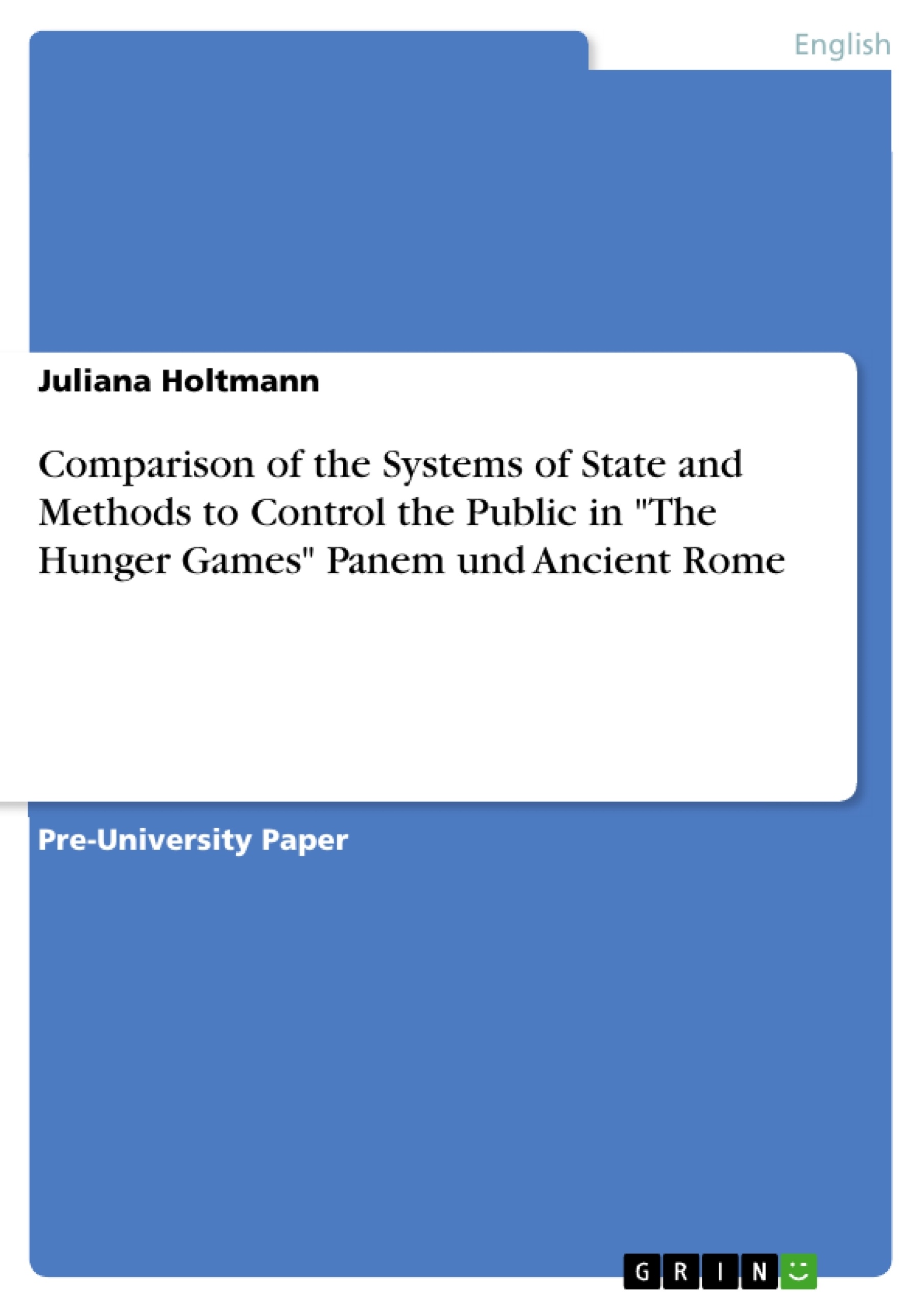The aim of this technical work is to compare the state system of Ancient Rome and Panem, from the fictional novel series "The Hunger Games" by Suzsanne Collins, and to highlight the methods of both governments in order to keep the public under control. I will investigate which system of state worked better and which one used the more successful methods to keep the people under control.
In this work, after a basic definition of the subject dystopian literature and the two states, their systems, rulers and methods to control the people, I will uncover the various similarities between Ancient Rome and Panem, the state from the novels, especially with regard to their systems of state, including their dictators and rebellions, and their control over the public. The work ends with a conclusion.
Inhaltsverzeichnis (Table of Contents)
- 1 Introduction
- 2 Main Part.
- 2.1 The Definition of Ancient Rome.
- 2.2 The Definition of Dystopian Literature.
- 2.3 The Definition of Panem
- 2.4 Rome: The System of State.
- 2.5 Gaius Iulius Caesar..
- 2.6 Rome: Methods to Control the Public.
- 2.6a Panem et Circenses in Ancient Rome
- 2.6b The Gladiator Fights
- 2.7 Panem: The System of State
- 2.8 Coriolanus Snow.
- 2.9 Panem: Methods to Control the Public.
- 2.9a Panem et Circenses in Panem..
- 2.9b The Hunger Games.
- 2.10 Comparison of Ancient Rome and Panem..
- 2.10a Systems of State..
- 2.10b Caesar and President Snow
- 2.10c The Rebellions
- 2.10d Methods to Control the Public.
- 3 Conclusion.........
Zielsetzung und Themenschwerpunkte (Objectives and Key Themes)
This technical work compares the state systems of Ancient Rome and Panem, highlighting the methods used by both governments to control the public. The primary objective is to determine which state system was more effective and which employed more successful methods of public control. Key themes explored include:- The similarities and differences between the state systems of Ancient Rome and Panem.
- The methods employed by both governments to control the public.
- The effectiveness of these methods.
- The dangers of political or social systems that are oppressive and dehumanizing.
- The importance of understanding history to avoid repeating mistakes.
Zusammenfassung der Kapitel (Chapter Summaries)
- Chapter 2.1 introduces the origins and development of Ancient Rome, highlighting its transition from a small town to a powerful empire. It explores the city's political, cultural, and social significance, as well as the role of religion and the construction of the Circus Maximus and Colosseum.
- Chapter 2.2 defines dystopian literature as a form of speculative fiction that presents a frightening and dehumanizing imagined society. It contrasts dystopian literature with utopian literature and discusses its potential to warn readers about the dangers of political and social systems.
- Chapter 2.3 defines Panem, the imaginary dystopian state created by Suzanne Collins in her novel series "The Hunger Games". It describes the state's origins, its social structure, and the events that led to the rebellion against the Capitol.
- Chapter 2.4 examines the system of state in Ancient Rome, discussing its political structure, the role of elected officials, the Senate, and the transition to an empire under Gaius Iulius Caesar.
- Chapter 2.5 provides a more detailed look at the life and influence of Gaius Iulius Caesar, exploring his role in the end of the Roman Republic and the emergence of the Roman Empire.
- Chapter 2.6 analyzes the methods used by Ancient Rome to control the public, focusing on the use of "panem et circenses" and gladiatorial fights as means of distraction and entertainment.
- Chapter 2.7 describes the state system of Panem, highlighting its totalitarian government, the Capitol, and the districts responsible for specific goods.
- Chapter 2.8 examines the character of Coriolanus Snow, the president of Panem, and his role in controlling the districts and the public.
- Chapter 2.9 analyzes the methods used by Panem to control the public, focusing on the "panem et circenses" strategy and the Hunger Games, which served as a means of both entertainment and control.
- Chapter 2.10 compares the state systems, rulers, rebellions, and methods of public control employed by Ancient Rome and Panem, highlighting both similarities and differences.
Schlüsselwörter (Keywords)
This work focuses on the comparison of two distinct state systems, Ancient Rome and Panem, as depicted in the novels "The Hunger Games". Key terms include dystopian literature, state systems, political control, methods of control, "panem et circenses," gladiatorial fights, the Hunger Games, rebellions, and historical parallels. These terms represent the core concepts and themes explored in the work, emphasizing the power of political systems to control the public and the dangers of oppression and social inequality.- Quote paper
- Juliana Holtmann (Author), 2021, Comparison of the Systems of State and Methods to Control the Public in "The Hunger Games" Panem und Ancient Rome, Munich, GRIN Verlag, https://www.hausarbeiten.de/document/1421667


